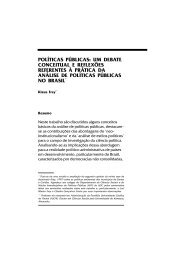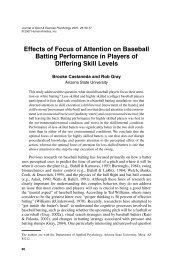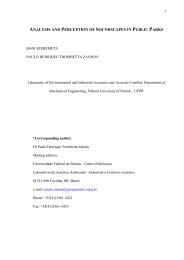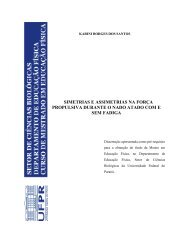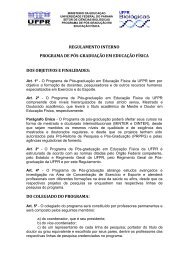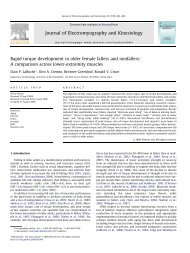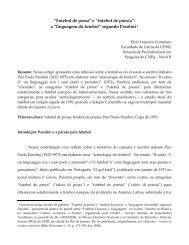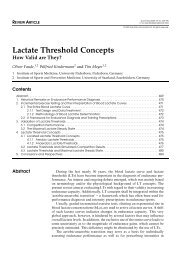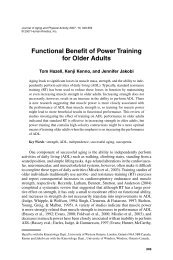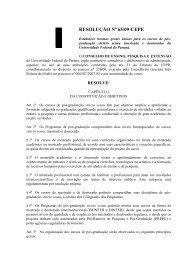Measurement of cortisol in human hair as a biomarker of ... - UFPR
Measurement of cortisol in human hair as a biomarker of ... - UFPR
Measurement of cortisol in human hair as a biomarker of ... - UFPR
Create successful ePaper yourself
Turn your PDF publications into a flip-book with our unique Google optimized e-Paper software.
Sauvé et al. <strong>Me<strong>as</strong>urement</strong> <strong>of</strong> <strong>cortisol</strong> <strong>in</strong> <strong>hair</strong><br />
samples either need to be taken at specific times <strong>of</strong> the<br />
day (saliva and serum), or require a laborious collection<br />
method (24 hr ur<strong>in</strong>e collection), mak<strong>in</strong>g them unsuitable<br />
for population analysis. 1 Even 24-hr ur<strong>in</strong>e<br />
collection reflects the l<strong>as</strong>t day and not changes that<br />
can occur over weeks to months.<br />
Hair analysis is <strong>in</strong>cre<strong>as</strong><strong>in</strong>gly used to reflect exposure<br />
to drugs <strong>of</strong> abuse and environmental tox<strong>in</strong>s. 2 Incorporation<br />
<strong>of</strong> hormones <strong>in</strong> <strong>hair</strong> is thought to occur<br />
ma<strong>in</strong>ly via blood circulation dur<strong>in</strong>g the formation <strong>of</strong><br />
the <strong>hair</strong> shaft. 3 Because <strong>of</strong> the balance exist<strong>in</strong>g between<br />
serum levels and <strong>hair</strong> concentration, me<strong>as</strong>urement<br />
<strong>of</strong> endogenously produced hormonal levels <strong>in</strong><br />
<strong>hair</strong> may reflect average hormone levels over months.<br />
Specifically, because <strong>hair</strong> grows approximately 1 centimeter<br />
per month (range 0.6-1.4 cm) 4 , a <strong>hair</strong> sample<br />
<strong>of</strong> 2-3 cm reflects average hormone levels over the<br />
previous 2-3 months. Hence, unlike other matrices,<br />
<strong>hair</strong> <strong>cortisol</strong> may represent long-term exposure to the<br />
hormone.<br />
Dur<strong>in</strong>g the l<strong>as</strong>t few years, the Str<strong>as</strong>bourg group<br />
h<strong>as</strong> reported me<strong>as</strong>urement <strong>of</strong> <strong>cortisol</strong> <strong>in</strong> <strong>human</strong> <strong>hair</strong>. 5,6<br />
Until now, no studies have contr<strong>as</strong>ted <strong>cortisol</strong> levels <strong>in</strong><br />
<strong>hair</strong> with me<strong>as</strong>urements <strong>of</strong> <strong>cortisol</strong> <strong>in</strong> saliva, serum<br />
and/or ur<strong>in</strong>e <strong>cortisol</strong> with<strong>in</strong> the same <strong>in</strong>dividuals. The<br />
objective <strong>of</strong> the present study w<strong>as</strong> to develop an <strong>as</strong>say<br />
for me<strong>as</strong>ur<strong>in</strong>g <strong>cortisol</strong> <strong>in</strong> <strong>hair</strong>, to determ<strong>in</strong>e a reference<br />
range for <strong>cortisol</strong> <strong>in</strong> <strong>hair</strong> <strong>in</strong> a non-obese control population,<br />
and to correlate these novel me<strong>as</strong>ures with <strong>cortisol</strong><br />
levels <strong>in</strong> serum, saliva and 24-hour ur<strong>in</strong>e.<br />
Methods<br />
A) Evaluation <strong>of</strong> ELISA <strong>as</strong>say for <strong>hair</strong> <strong>cortisol</strong><br />
The study w<strong>as</strong> approved by the Research Ethics Board<br />
<strong>of</strong> the University <strong>of</strong> Western Ontario, and written <strong>in</strong>formed<br />
consent w<strong>as</strong> obta<strong>in</strong>ed from all subjects prior to<br />
participation.<br />
Hair collection<br />
Hair samples consist<strong>in</strong>g <strong>of</strong> approximately 150 strands<br />
<strong>of</strong> <strong>hair</strong> or approximately 20 mg, were collected from<br />
the posterior vertex. The <strong>hair</strong> w<strong>as</strong> cut with scissors <strong>as</strong><br />
close to the scalp <strong>as</strong> possible. The <strong>hair</strong> w<strong>as</strong> then taped<br />
to a piece <strong>of</strong> paper us<strong>in</strong>g Scotch®Tape, the scalp end<br />
w<strong>as</strong> clearly marked and the sample w<strong>as</strong> stored <strong>in</strong> an<br />
envelope <strong>in</strong> room temperature up to 12 months before<br />
analysis.<br />
Hair sample preparation<br />
Samples were prepared us<strong>in</strong>g methods that have been<br />
previously reported by our lab (Yamada et al, 7 ). A<br />
m<strong>in</strong>imum <strong>of</strong> 10 mg <strong>of</strong> <strong>hair</strong> from the scalp end w<strong>as</strong><br />
used for each sample. The <strong>hair</strong> w<strong>as</strong> weighed, cut <strong>in</strong>to<br />
small pieces us<strong>in</strong>g small surgical scissors, put <strong>in</strong>to a<br />
disposable gl<strong>as</strong>s sc<strong>in</strong>tillation vial and 1 ml <strong>of</strong> methanol<br />
w<strong>as</strong> added. The sc<strong>in</strong>tillation vial w<strong>as</strong> sealed and<br />
<strong>in</strong>cubated overnight (~16 hr) at 52 °C while shak<strong>in</strong>g<br />
(Gyromax® Amerex Instruments Inc.). After <strong>in</strong>cubation,<br />
the supernatant w<strong>as</strong> removed and put <strong>in</strong>to disposable<br />
gl<strong>as</strong>s culture tubes. The supernatant w<strong>as</strong><br />
evaporated <strong>in</strong> a dry bath (Thermolyne® Dri-Bath) under<br />
nitrogen (Techne® Sample Concentrator) until<br />
completely dry. Once the methanol w<strong>as</strong> removed, the<br />
sample w<strong>as</strong> resuspended <strong>in</strong> 150-250 μL <strong>of</strong> phosphate<br />
buffered sal<strong>in</strong>e (PBS) at pH 8.0. Samples were vortexed<br />
for one m<strong>in</strong>ute followed by another 30 seconds<br />
until they were well mixed.<br />
Hair <strong>cortisol</strong> analysis<br />
The <strong>cortisol</strong> <strong>in</strong> the <strong>hair</strong> samples w<strong>as</strong> me<strong>as</strong>ured us<strong>in</strong>g<br />
the Salivary ELISA Cortisol kit© (Alpco Diagnostics®,<br />
W<strong>in</strong>dham, NH) <strong>as</strong> per the manufacturer’s directions<br />
with the reagents provided. The cross reactivity<br />
<strong>of</strong> other steroids with the kit’s antibodies w<strong>as</strong> reported<br />
<strong>as</strong> follows: corticosterone 31%, progesterone



